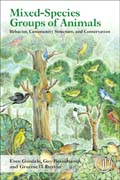
Mixed-Species Groups of Animals: Behavior, Community Structure, and Conservation
Goodale, Eben
Beauchamp, Guy
Ruxton, Graeme D.
Mixed-Species Groups of Animals: Behavior, Community Structure, and Conservation presents a comprehensive discussion on the mixed-species groups of animals, a spectacular and accessible example of the complexity of species interactions. They are found in a wide range of animals, including invertebrates, fish, mammals and birds, and in different habitats, both terrestrial and aquatic, throughout the world. While there are more than 500 articles on this subject scattered in separate categories of journals, there has yet to be a general, cross-taxa book-length introduction to this subject that summarizes the behavior and community structure of these groups. The authors first survey the diversity of spatial associations among animals and then concentrate on moving groups. They review the major classes of theories that have been developed to explain their presence, particularly in how groups increase foraging efficiency and decrease predation. Finally, they explore the intricacies of species interactions, such as communication, that explain species roles in groups and discuss what implications these social systems have for conservation. Functions as a single resource for readers inside and outside of academia on mixed-species groups, serving as a foundation for future research in this field Begins with an empirical summary of mixed-species distribution and reviews how the theories explaining their adaptive benefits are supported by the evidenceIncludes many aspects of mixed-group behavior (e.g. foraging, communication, collective decision-making, dominance, social roles of species and leadership, relationship to conservation) that were not previously or easily accessible INDICE: 1. An introduction to a multidisciplinary field 2. A diversity of mixed-species groups that are either stationary, or form around moving resources 3. Schools, herds, flocks (moving groups, no moving resource) 4. Adaptive implications of mixed-species grouping I: Foraging and moving 5. Adaptive implications of mixed-species groups II: Predation, physical and social factors 6. Behavior in mixed-species groups 7. Roles in mixed-species groups 8. Conservation issues 9. Conclusions
- ISBN: 978-0-12-805355-3
- Editorial: Academic Press
- Encuadernacion: Rústica
- Páginas: 216
- Fecha Publicación: 11/05/2017
- Nº Volúmenes: 1
- Idioma: Inglés
